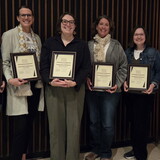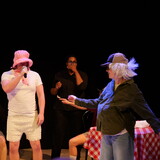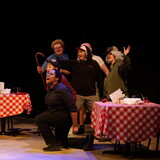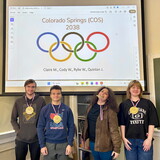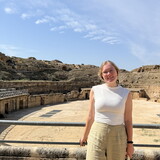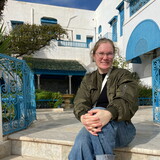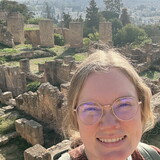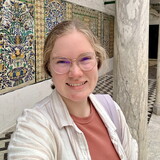When Nebraska Wesleyan University junior Ross Mumford agreed to be a student co-instructor in Sheryl Rinkol’s Liberal Arts Seminar, he had a lot of enthusiasm for teaching, but only average knowledge of the course matter: Boarding the Ship of Dreams: Sailing Across 100 Years of Titanic.
But after a semester with Rinkol, Mumford found a passion for the infamous ship and decided to team with his professor on a student-faculty collaborative research project in Belfast, Northern Ireland.
“The Titanic was not only a ship, but a reflection of the time period,” said Mumford, an elementary education major from Elmwood, Neb. “There’s a piece of the Titanic for everyone: engineering, social constructs, fashion, technological innovations.”
The three-week field trip gave Mumford and Rinkol an opportunity to forge relationships with the Shared History Interpretive Project (SHIP), the Belfast Titanic Society, and The Barge, a maritime history museum located in a barge on the river. Through these connections, and with the guidance of Rinkol, Mumford was able to study the Titanic, its impact on Belfast residents and tourists, and how well the space of the Harland and Wolff shipyard – the Titanic’s birthplace – has been used to represent the ship’s history.
Mumford collected 59 surveys and several interviews from residents and tourists. Through the friendships they forged with the Belfast Titanic Society, Mumford and Rinkol were given many once-in-a-lifetime opportunities that even some of the most seasoned Titanic scholars haven’t experienced.
One of the most notable experiences was an invitation to the unveiling of the newly restored Nomadic, the tender boat for the Titanic, which ferried passengers to the ship. Mumford and Rinkol were invited to the event by an ancestor of the Titanic’s chief architect, Thomas Andrews.
“You could actually go around and see what they restored,” said Rinkol, assistant director of NWU’s Cooper Center. “They had interactive stations where you could try on Edwardian clothes.”
While restoring the Nomadic, builders only used techniques appropriate for the time period, giving visitors the closest experience as possible to 1900’s shipbuilding.
Thanks to the Belfast Titanic Society, Mumford and Rinkol were also invited into the Thomas Andrews Memorial Hall, which is closed to the public.
Another unique experience was Mumford and Rinkol’s trip to St. Joseph’s Church in Sailortown, where many of the dockers who worked on the Titanic lived and attended church. Dockers were the men who loaded cargo onto the ship, and their story, said Rinkol, is largely untold.
“I really did not know about Sailortown or the story of the dockers,” said Rinkol, who has studied the Titanic for the past 30 years. “I hadn’t heard of them before the trip.”
Mumford and Rinkol will present their findings at NWU’s student symposium next spring. They’ve already had the opportunity to share their experiences with Lincoln area elementary and middle school students attending the Bright Lights summer program. They hope to return to Belfast to present their research to the friends and organizations they worked with.
This fall they will return to the classroom together to co-instruct another Liberal Art Seminar on the Titanic.
“Which is perfect now that we have all this newly acquired Belfast knowledge,” said Mumford.
Ultimately, Mumford said, the research and experience will benefit students in his own classroom someday.”
Both Mumford and Rinkol are quick to praise the university’s Student Faculty Collaborative Research Grant that allowed them to take this life-changing trip.
“I think it’s a phenomenal program,” said Rinkol. “To see Wesleyan supporting something that is an interest the students have is a great opportunity.”




